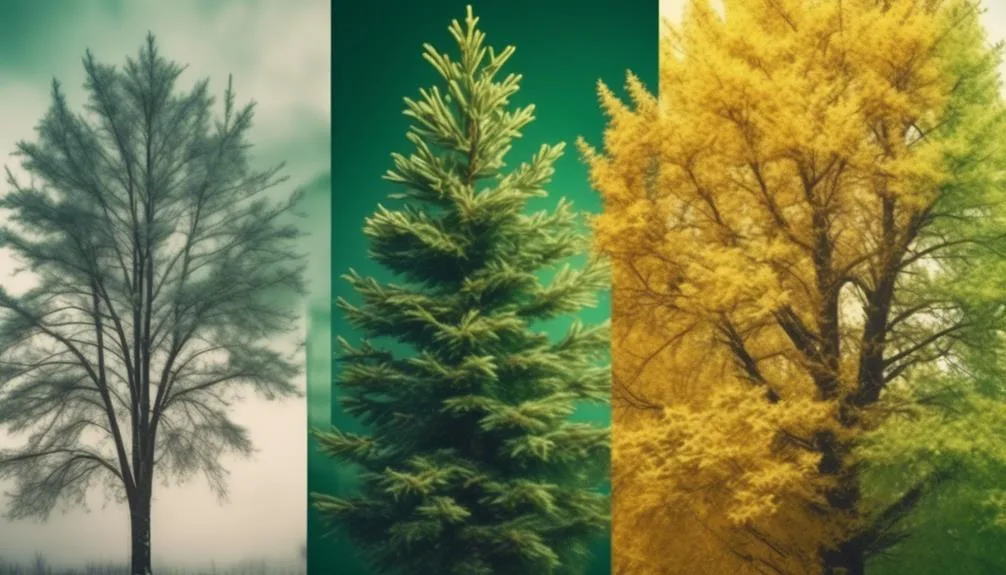Ever wondered why a spruce tree changes color throughout the year? It's a complex process influenced by factors like chlorophyll, sunlight, and temperature.
These mechanisms work together to create the captivating transformation we see. Understanding this natural process can offer insight into the adaptability and resilience of spruce trees.
The Role of Chlorophyll in Color Change
As the seasons transition and the days grow shorter, the role of chlorophyll in spruce tree color change becomes increasingly significant, influencing the vibrant transformation of their foliage.
Chlorophyll breakdown is a key factor in this process. As the amount of sunlight decreases, the production of chlorophyll slows down, revealing the other pigments present in the leaves. This leads to the stunning array of colors seen in autumn, as the trees adapt to the changing light and temperature conditions.
The color spectrum adaptation allows the trees to maximize their energy absorption during the shorter days, aiding in their preparation for the upcoming winter. Understanding the intricate role of chlorophyll in this color change process provides insight into the remarkable resilience and adaptability of spruce trees.
Influence of Sunlight on Spruce Trees
When sunlight interacts with spruce trees, it triggers a series of biological responses that play a crucial role in their growth and development throughout the year. Sunlight exposure is essential for spruce trees as it serves as the primary source of energy for photosynthesis, the process through which they produce their own food.
The duration and intensity of sunlight directly influence the growth patterns of spruce trees. During the spring and summer, increased sunlight exposure stimulates the production of chlorophyll, the pigment responsible for the tree's green color and essential for photosynthesis. This abundance of chlorophyll leads to vigorous growth and the development of new shoots and needles.
In contrast, reduced sunlight exposure in the fall and winter triggers the breakdown of chlorophyll, causing the tree's color to change and its growth to slow down in preparation for the colder months.
Temperature's Impact on Color Transformation
The changes in sunlight exposure influence the temperature's impact on the color transformation of spruce trees throughout the year. The temperature plays a crucial role in determining the foliage color of spruce trees, contributing to the breathtaking transformation they undergo with each seasonal change. Here's how temperature affects the color transformation:
- Chlorophyll Breakdown: As temperatures drop, chlorophyll production decreases, leading to the breakdown of this green pigment and revealing the underlying colors of the foliage.
- Anthocyanin Production: Cooler temperatures trigger the production of anthocyanins, leading to vibrant red and purple hues in the spruce tree foliage.
- Climate Variability: Fluctuations in temperature due to climate variability can impact the timing and intensity of the color transformation, making each year's display unique.
Understanding the interplay between temperature and foliage color provides insight into the captivating beauty of spruce trees throughout the year.
Understanding Pigments in Spruce Trees
Have you ever wondered what pigments are responsible for the stunning array of colors in spruce tree foliage throughout the year? Understanding the pigment distribution in spruce trees can shed light on the seasonal variations in their color. The key pigments involved in this process are chlorophyll, carotenoids, and anthocyanins. Here's a closer look at their roles in creating the vibrant hues of spruce tree foliage:
| Pigment | Color |
|---|---|
| Chlorophyll | Green |
| Carotenoids | Yellow, Orange |
| Anthocyanins | Red, Purple, Blue |
Chlorophyll dominates during the growing season, giving the needles their characteristic green color. As the days shorten and temperatures drop, chlorophyll production decreases, allowing the other pigments to become more prominent, resulting in the stunning autumnal display of colors. Understanding these pigment dynamics enriches the appreciation of the natural beauty of spruce trees.
Adaptation to Changing Seasons
Adapting to the changing seasons, spruce trees undergo a remarkable transformation, reflecting nature's ingenious response to the shifting environment.
- Seasonal Growth: As temperatures drop and daylight hours decrease, spruce trees enter a period of dormancy, slowing down their growth processes to conserve energy and resources.
- Environmental Cues: The color change in spruce trees is triggered by environmental cues such as temperature and light, signaling the tree to prepare for the upcoming season. These cues prompt the tree to adjust its physiological processes, leading to the vibrant displays of color.
- Adaptive Mechanisms: To cope with the changing seasons, spruce trees adjust their metabolic activities, altering the production of pigments and modifying their foliage to withstand the harsh conditions. This remarkable ability allows them to thrive in diverse climates and showcases the beauty of nature's adaptive strategies.
Conclusion
In observing the changing colors of a spruce tree, we witness nature's remarkable ability to adapt and thrive.
From the interplay of chlorophyll to the impact of sunlight and temperature, the tree reflects the ever-changing seasons.
It serves as a beautiful reminder of nature's resilience and its capacity to flourish in diverse conditions.

My interest in trees started when I first saw the giant sequoias in Yosemite.
I was a teenager then, and I remember thinking, “I need to learn more about this.”
That moment stuck with me.
A few years later, I went on to study forestry at Michigan Tech.
Since graduating, I’ve worked in a mix of hands-on tree care and community education.
I’ve spent over ten years helping people understand how to plant, maintain, and protect the trees in their neighborhoods.
I don’t see trees as just part of the landscape.
They are living things that make a real difference in our daily lives.
